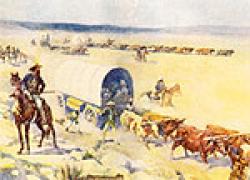
Published date
8 August 1938
The Great Trek was a migration that took place between 1838 and the 1840s, and involved the Boers leaving the Cape Colony and settling in the interior of South Africa. White settlement led to the establishment of the republics of Natalia, the Orange Free State and the Transvaal. Among the reasons for the trek was the general dissatisfaction with British colonial rule in the Cape Colony.
The language (Afrikaans), religion and struggles faced by the Voortrekkers created a common identity. This was expressed in the form of Afrikaner nationalism which had reached its peak in 1938 with the 100 year celebration of the Great Trek. These centenary celebrations culminated in a symbolic trek from Cape Town to Pretoria.
This re-enactment of the trek began on 8 August 1938, at the foot of the Jan van Riebeeck statue in Cape Town, and sparked mass enthusiasm amongst Afrikaners as it wound its way through small towns. Spectators were often dressed in Voortrekker clothing, and held solemn ceremonies where wreaths were laid on the graves of Afrikaner heroes and streets were renamed in their honour.
The event ended in Pretoria with the laying of the foundation for the Voortrekker Monument, which was attended by a crowd of over 100 000 people. The purpose of the centenary celebrations was to further the Afrikaner cause and to encourage a greater sense of unity and solidarity. Organizations such as the Afrikaanse Taal- en Kultuurvereniging (ATKV) and the Afrikaner Broederbond continued to promote this cause throughout the 20th century.
References
Cameron, T. (ed) (1986) An Illustrated History of South Africa. Johannesburg, pp.258-259.|
Gilliomee, H. & Mbenga, B. (2007) New History of South Africa. Cape Town, pp.290-291.